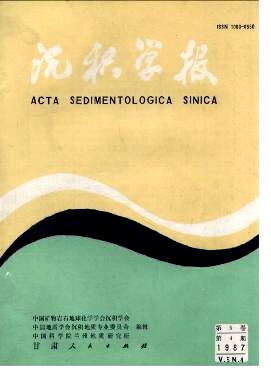THE STRATUM AND SEDIMENTARY ENVIRONMENTS OF HALAALATE MOUNTAIN AREA, XINJIANG
- Publish Date: 1987-12-10
Abstract: Halaalate Mountain, situated in the northwest margin of the Junggar Basin in Xinjiang, Crops out Middle Carboniferous Series. The opinions about the age of this stratum are different because there are only a few fossils in it. B. A. Obarugieve considered that it was Silurian. Mr. Hao Fuguang held that it was Devonian in 1964. Area Geological Team of Xinjiang defined it as Lower and Middle Carboniferous Series in 1979. In terms of fossil assemblages found and absolute age of rocks by K-Ar, we put these strata to Middle Carboniferous Series and Lover Permian Series, and set up the new sequence. Halaalate Formation: According to lithological characters, it can be divided into three members:Lower Member is mainly involved grey-green volcaniclastic and volcanic rock(andesite and basalt) with a few limestone lenticles, Medium Member the grey-black sandy shale with fine grained sandstones, Upper Member grey medium-course grained sandstones. The fossil assemblages in the formation are as follows: Brachiopoda: Enteletina unclata Jin et Liao, Kutorginella Tentoria Jin et Liao, Waagenoconcha aff. sarytchevae(Bened), Fusulina: Fseudoslaffella cf. varsonofievae Rauser These fossils often occured in Bashkirira Age. The absolute age of rocks in the formation is 282-310Ma. So, the Halaalate Formation should belong to Middle Carboniferous Series. Aladeyiksai Formation: It overlies the Halaalate Formation. The contact between two formations is conformable It contains fossils: Fusulina: Pseudosiaffella timonica, Profusulinella parafittsi and Profusulinella trisulcata. These fossils belong to Moscovian Age. Therefore, Aladayikesai Formation must lie on Halaalate Formation. The Lower Member of Jiamuhe Formation; There are some fossils in the bottom beel of the Member. They are: Bryozoa: Fistulepora sp. and Fenestella sp. Hydroid polyp; Malacostroma sp. The value of absolute age of the rock is 241-267Ma. The member should belong to Lower Permian Series, but not Lower Carboniferous Series. According to the characters of paleoecology, rock assemblage and combined relation among elements and other marks in the stratum of the Halaalate Mountain area, the sedimentary facies were referred to as: Halaalate Formation: The lower member represents neritic deposit associated with much volcanic emanation, the medium member littoral sub-closed lagoon environment in which the sea water was desalted, the upper member littoral environment. Aladeyikesai age suggests clastic deposit in littoral tidal flat environment. The Lower Member of Jiamuhe Formation indicates the environment of a continental volcanic emanation, which was companyed with short ingression in the earlier stage and became continental flood deposit in the front of mountains in the later. The evolutional history of the sedimentary facies: Marine transgression took place in Medium Carboniferous Epoch. Halaalate area was inundated by sea water, and became wide littoral trench associated with vigorous volcanic activity. The velocity of deposition was faster. Then the sea water from north to south. Sub-closed lagoon environment occured in this area. Because fresh water from terrigenous area flowed into the lagoon, water in the lagoon was desalted. After that, on the effect of vibration of the sea water, the lagoon destroyed and evolved littoral beach until littoral tidal flat environment. In Late Carboniferous Epoch, this area was raised and became mountains. Then the area suffered disintegration. During Early Permian Epoch, volcanoes erupted again, geographic undulation increased and very thick flood deposits(drifted material laved) on the volcanic rocks.
| Citation: | Ma Baolin. THE STRATUM AND SEDIMENTARY ENVIRONMENTS OF HALAALATE MOUNTAIN AREA, XINJIANG[J]. Acta Sedimentologica Sinica, 1987, 5(4): 66-77. |






 DownLoad:
DownLoad: